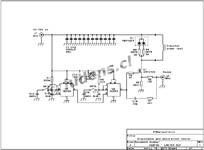vathsal
Newbie

Hi ,
I am designing a Fly-back converter i had calculated most of the components but i am having some doubt. I am having following data
Primary Peak current = 1.6 A
Secondary Current = 9 A
should my primary inductor saturation should be more than 1.6 A to be operated in full load.
I am designing a Fly-back converter i had calculated most of the components but i am having some doubt. I am having following data
Primary Peak current = 1.6 A
Secondary Current = 9 A
should my primary inductor saturation should be more than 1.6 A to be operated in full load.


